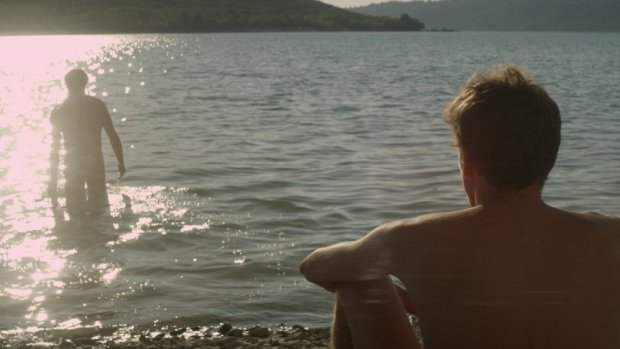We still live in an age where sexually explicit films stand out firstly, and often only, on account of that explicitness. Think Gaspar Noe’s recent Love 3D (2015) and Lars von Trier’s wildly uneven Nymphomanic (2013). Alan Guiraudie’s Stranger by the Lake (2013) is certainly one of the most sexually explicit films I’ve ever seen, but the film’s style and economical storytelling linger a lot longer than the sex.
Stranger by the Lake opens with a slow first half, focused very much on the process of daily life. It begins with an almost silent sequence of a man arriving at a cruising spot, laying down the actions of being there – driving up, parking his car, walking to the beach through a forest, swimming and chatting to a couple of other men. The other predominant focus of the first part of the film is the establishment of character, which Guiraudie does in a very economic manner. In a way, what are being set up are archetypes, though that term does a disservice to the skill involved. Especially effective is the character of Henri, a man who sits apart from the rest of the cruising scene. This distance, his awkwardness and frumpy polo shirt, tell the audience everything they need to know about the character. It’s exposition through costume and placement of characters in space, rather than resorting to dialogue driven backstories. Similarly, with his moustache, tan and Adonis like body, we sense the alluring nature and dangerous physicality of Michel from the start, an element of that character that will haunt the main character Franck for the rest of the film.
Through the second half of Stranger by the Lake, two genres – thriller and crime – influence the film heavily. This part of the film begins with a murder, seen from a high angle, stationary shot, allowing the action to unfold just as it would be viewed in real life, but with the audience helpless to intervene. The crime aspects are the weaker of the two and perhaps some of the weakest parts of the film overall. The questioning of the various men at the lake by a lone detective is bland and laboured with no spark to the writing. The viewer never feels that the detective is serious about solving the case and there is no police-procedural style detail. The presence of the detective does help to provoke paranoia amongst some of the characters. But that could probably be generated in other ways. Thankfully though these sequences don’t take up much of the film and as a result do not affect its quality overall. In terms of the thriller aspects though, the film succeeds heartily, with an unconventional approach. Much of it is a creation of tension through omission. A body lies in the lake but doesn’t wash ashore or show up. The tension of if, and will it show up looms over the characters at the cruising spot. Similarly the simple fact of a character ceasing to show up creates tension as to their whereabouts and what they have done. The reflection of moments and interactions from the first half of the film, as well as the way Guiraudie strings those moments out, is another way in which major tension is elicited.
The widescreen shooting of the film looks totally spectacular. Much of the setting is established by a succession of glorious shots of the lake shimmering in the late evening light. The beautiful shots do not simply deliver on a visual level either, Guiraudie uses them as an integral part of his storytelling approach. The position, and especially the stationary nature of the camera, gives a sense of space and perspective. Late in the film, a shot mimics the set up when the murder was committed, building a serious amount of tension through this simple yet creative repetition, especially as it renders the audience feeling doubly powerless to intervene. Clouds rolling ever so slowly across the screen show the passing of time, as does the repeated shot of Franck’s car arriving each day, the only identifier that another day at the lake has begun. These shots are a structural tic that gives the film rhythm and progression. It’s not just time passing on a simple level, but also the advent of change – both change in a seismic life altering sense and also slow and infinitesimal change, which goes unnoticed until it is too late.
Verdict: Stranger by the Lake is a damn pretty thriller. One where the tension comes from very astute writing and the manner in which moments from the first half of the film are reflected and folded back on themselves. It all leads to an ending that, whilst a touch signposted, tears the emotional heart of the film asunder, albeit still in its understated way. Pint of Kilkenny
Related beermovie.net articles for you to check out: Locke and Tom at the Farm.
Like what you read? Then please like Beermovie.net on facebook here and follow me on twitter @beer_movie


Really wonderful write-up. I’ve always meant to see this as a result of the poster being so visually appealing, strangely enough, but it sounds excellent. Will escalate on the to-watch list!
Thanks for commenting Anna! Yep, I love that poster too. It’s a really interesting arthouse thriller. Well worth taking the time to check out.
Sounds like a great one. Love the opening line. Could not possibly agree more good sir.